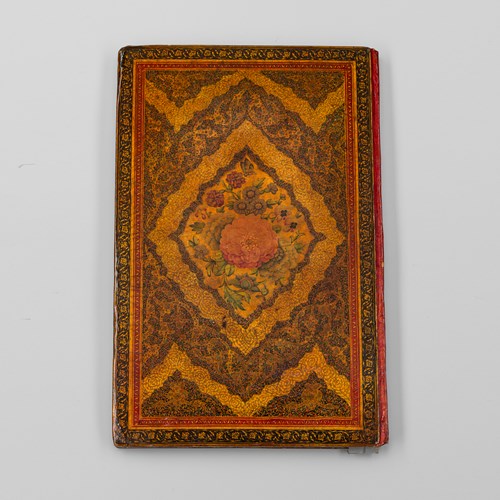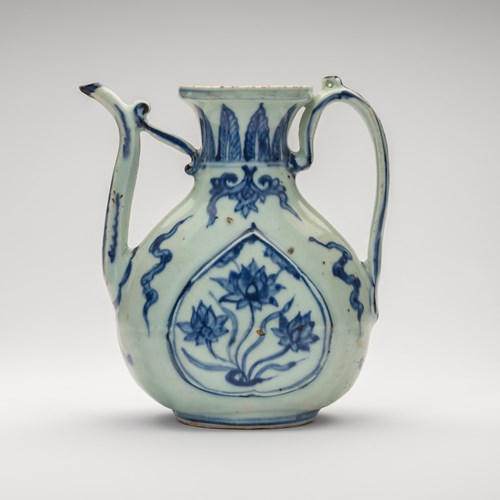Marketplace
Mamluk Revival Mosque Lamp
Of green transparent glass with ornamentation applied in blue, red, green, and white enamels, this lamp was made in the late 19th century by the Belgian-born orientalist glassmaker Philippe-Joseph Brocard in the style of a 14th century Mamluk mosque lamp. On the flared neck is a thuluth inscription in reserve on a blue ground decorated with swirling vines. It reads:
‘izz li-mawlana al-sultan al-malik al-‘alim al-‘adil al-malik al-nasir ‘azza nasruhu
‘Glory to our lord, the Sultan, the King, the Learned, the Just, al-Malik al-Nasir, may his victory be glorified.’
On its splayed pedestal base is the repeated word al-'alim, meaning 'The Learned'. Around the bottom of the body are alternating roundels and shield-shaped medallions filled with pseudo-Arabic inscriptions. Six lug handles have been applied to the bulbous body, from which the lamp could be hung from the ceiling.
Brocard began his career as a conservator of glass at the Musée de Cluny and the Musée des Arts Décoratifs in Paris. He was captivated by the 14th century Mamluk mosque lamps in these collections, and recognising the demand for antique Islamic glassware in France in the 1860s, began to recreate them. He initially copied the Mamluk designs faithfully, but from the mid 1870s onwards he began to alter the designs.1 Brocard pioneered the revival of Islamic enamelling techniques, applying vitreous enamels to the surface of the vessel along with gold leaf, which were then fused to the glass by the firing process.2 His work was first displayed at the Paris Exhibition of 1867, and went on to be shown at the 1871 International Exhibition in London, the Vienna Exhibition of 1873, and the Paris Exhibition of 1878.3
The present example appears to be based on an amalgamation of two lamps in French collections. The first, in the collection of the Musée des Arts Décoratifs, Paris (inv. no. 4409), is similar in form and ornamentation to the present example. Dedicated to Sultan Baybars II, it is dated 709 (1309-1310 CE). A blue calligraphic band runs around the neck, with foliage and thuluth calligraphy applied in reserve. Delicate floral patterns created in fine red enamel form a backdrop for the rest of the ornamentation. The second, also dated to 1309-1310, is now in the Metropolitan Museum of Art, New York (accession no. 17.190.987), but belonged to the collection of Charles Mannheim in Paris until 1910. Though the decorative language is similar to both the Baybars lamp and the present example, it is the inscriptions from which Brocard appears to have drawn inspiration. The inscription around the neck is the same as that of the present Brocard lamp, although it is applied with red enamel rather than blue. A section of the inscription on its body, which reads 'al alim' in blue enamel, appears to have been appropriated to form the repeating inscription on the foot of the present lamp. Both the Mamluk examples are made from pinkish-brown glass rather than the distinctive pale green of Brocard's glass. Furthermore, their blue is darker, which Edward Dillon suggests is because Brocard used cobalt rather than lapis.4
An almost identical lamp made by Brocard, dated to 1860-1880, is held in the Corning Museum of Glass, New York (accession no. 78.3.17). The glass is slightly more yellow in hue, but the ornamentation is remarkably similar and the inscriptions identical. A second Brocard lamp in the Corning Museum (accession no. 53.3.20) has clearly been modelled after the same prototypes, but is made from brownish-yellow glass. A mosque lamp at the Louvre Abu Dhabi (accession no. LAD 2012.011) lacks the splayed pedestal, sitting instead on a foot ring. However, the body and neck share very close ornamentation and colours, and the glass itself is the same transparent colour. A lamp signed by Brocard and dated 1870 on its base was sold at auction in 2022. Its inscriptions and ornamentation are identical to the present example, suggesting a contemporaneous date of manufacture.
n.b. accession nos are clickable links.
1 Rudoe, J. Decorative Arts 1850-1950: A Catalogue of the British Museum Collection. London: British Museum, 1991. p. 22. Cat. 27.
2 Ibid. p. 22.
3 Ibid. p. 23.
4 Dillon, Edward. Glass. London: Methuen, 1907. p. 152.
‘izz li-mawlana al-sultan al-malik al-‘alim al-‘adil al-malik al-nasir ‘azza nasruhu
‘Glory to our lord, the Sultan, the King, the Learned, the Just, al-Malik al-Nasir, may his victory be glorified.’
On its splayed pedestal base is the repeated word al-'alim, meaning 'The Learned'. Around the bottom of the body are alternating roundels and shield-shaped medallions filled with pseudo-Arabic inscriptions. Six lug handles have been applied to the bulbous body, from which the lamp could be hung from the ceiling.
Brocard began his career as a conservator of glass at the Musée de Cluny and the Musée des Arts Décoratifs in Paris. He was captivated by the 14th century Mamluk mosque lamps in these collections, and recognising the demand for antique Islamic glassware in France in the 1860s, began to recreate them. He initially copied the Mamluk designs faithfully, but from the mid 1870s onwards he began to alter the designs.1 Brocard pioneered the revival of Islamic enamelling techniques, applying vitreous enamels to the surface of the vessel along with gold leaf, which were then fused to the glass by the firing process.2 His work was first displayed at the Paris Exhibition of 1867, and went on to be shown at the 1871 International Exhibition in London, the Vienna Exhibition of 1873, and the Paris Exhibition of 1878.3
The present example appears to be based on an amalgamation of two lamps in French collections. The first, in the collection of the Musée des Arts Décoratifs, Paris (inv. no. 4409), is similar in form and ornamentation to the present example. Dedicated to Sultan Baybars II, it is dated 709 (1309-1310 CE). A blue calligraphic band runs around the neck, with foliage and thuluth calligraphy applied in reserve. Delicate floral patterns created in fine red enamel form a backdrop for the rest of the ornamentation. The second, also dated to 1309-1310, is now in the Metropolitan Museum of Art, New York (accession no. 17.190.987), but belonged to the collection of Charles Mannheim in Paris until 1910. Though the decorative language is similar to both the Baybars lamp and the present example, it is the inscriptions from which Brocard appears to have drawn inspiration. The inscription around the neck is the same as that of the present Brocard lamp, although it is applied with red enamel rather than blue. A section of the inscription on its body, which reads 'al alim' in blue enamel, appears to have been appropriated to form the repeating inscription on the foot of the present lamp. Both the Mamluk examples are made from pinkish-brown glass rather than the distinctive pale green of Brocard's glass. Furthermore, their blue is darker, which Edward Dillon suggests is because Brocard used cobalt rather than lapis.4
An almost identical lamp made by Brocard, dated to 1860-1880, is held in the Corning Museum of Glass, New York (accession no. 78.3.17). The glass is slightly more yellow in hue, but the ornamentation is remarkably similar and the inscriptions identical. A second Brocard lamp in the Corning Museum (accession no. 53.3.20) has clearly been modelled after the same prototypes, but is made from brownish-yellow glass. A mosque lamp at the Louvre Abu Dhabi (accession no. LAD 2012.011) lacks the splayed pedestal, sitting instead on a foot ring. However, the body and neck share very close ornamentation and colours, and the glass itself is the same transparent colour. A lamp signed by Brocard and dated 1870 on its base was sold at auction in 2022. Its inscriptions and ornamentation are identical to the present example, suggesting a contemporaneous date of manufacture.
n.b. accession nos are clickable links.
1 Rudoe, J. Decorative Arts 1850-1950: A Catalogue of the British Museum Collection. London: British Museum, 1991. p. 22. Cat. 27.
2 Ibid. p. 22.
3 Ibid. p. 23.
4 Dillon, Edward. Glass. London: Methuen, 1907. p. 152.
More artworks from the Gallery









